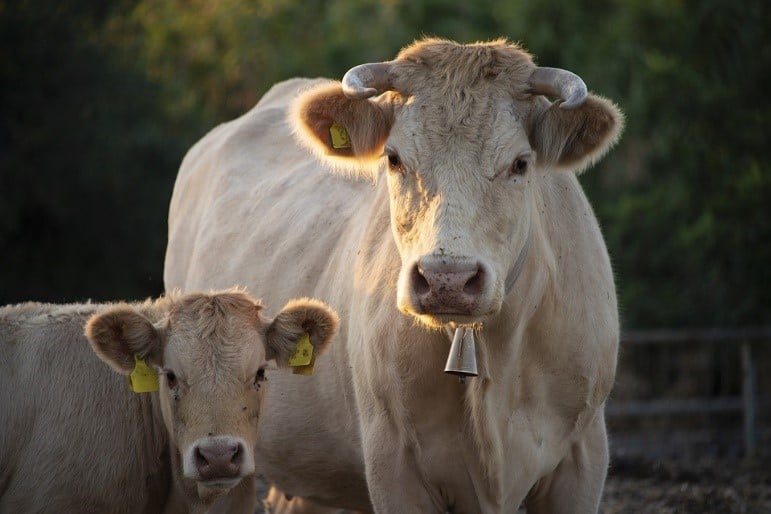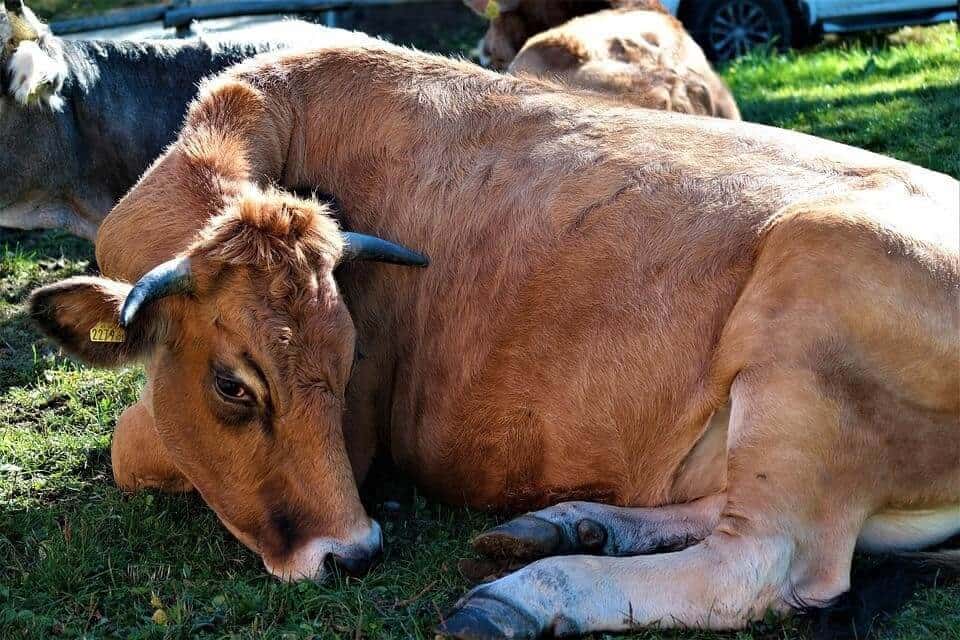There’s a popular Dad joke about cows: Why do cows have hooves instead of feet? — Because they lactose. As far as painful jokes go, this one is up there with the best of them. However, if you take the time to look at the joke, you will realize there’s a valid question.
Why Do Cows Have Hooves Instead of Feet ?
Let’s take a quick look at the anatomy of a cow’s foot and try to see why they have hooves instead of feet and why horses need shoes but not cows.
What Kind of Hooves Do Cows Have?
Instead of feet, cows have what are known as cloven hooves. Looking at a cow’s legs, you can see why they have cloven hooves. Their hooves are split down the middle and resemble a cloverleaf. These hooves have two claw-like structures that look like toes.
Which leads to a very interesting question: Do cows have toes? More on that shortly.
Why Do Cows Have Hooves?
Like most creatures in this world, cows evolved to have a body that serves them best in their environment. One of the main reasons why cows have hooves instead of feet is that hooves benefit them most while walking and running over many different types of rough terrain.
Cows were domesticated in the 9th millennium BC. Before that, they ran around like most wild animals. Cows would migrate from pasture to pasture, leading them to many different types of terrain. Developing hooves instead of feet was most beneficial to the survival and functionality of the cow.
This benefit could still be felt centuries later after cows were domesticated. Cattle drives would see herders driving herds of cattle for more than 25 miles daily across different terrain in North America. This was tiring for the cows and herders and also quite demanding on their hooves.
Thankfully, these hooves can take quite a bit of abuse as their tough outer layers keep up with the demands of the terrain. Compared to soft, fleshy paws or feet, hooves offer better protection and aren’t as prone to infections that may come from cuts and bruises over rough terrain.
Furthermore, cows tend to be heavy, and their hooves can provide them with the support they need to hold up their massive bodies.
What Are Cows Hooves Made of?
A cow’s hooves are a lot like human fingernails. They are made out of keratin, a protein that also makes up human hair and nails. This means that a cow’s hooves are as sensitive as human nails. It also means that a cow’s hooves are just as durable and can grow as much as human nails.
How Long Can Cow Hooves Grow?
Unchecked, cow hooves can keep growing. However, they tend to grow at a very slow rate (around two inches every year). In fact, this is such a standard rate of growth that veterinarian doctors advise cow raisers to keep an eye on the animal’s hooves.
If they happen to grow faster than the two inches per year rate, it could mean that your cows are consuming too much grain or high-quality forage in their diet, causing an excessive energy intake.
This, in turn, means that you are either giving them too much grain or that your cows are eating the wrong type of forage—more than they need or than is ideal for the cow’s age.
Any time you see your cows getting overgrown hooves, you need to trim them as soon as possible. Left unchecked, overgrown hooves can become deformed and painful for the cow. If left unchecked for too long, these overgrown hooves will not only be painful for the cow when walking but could also cause lameness.

Can Cow Hooves Crack?
Yes, cow hooves can crack. This usually happens to cows that live in very cold or dry areas. The cold typically makes the hooves brittle, especially during winter. This tends to happen because cow hooves have a much lower moisture content during the cold seasons than in summer.
That, however, isn’t the only reason cows may get cracked hooves. A nutritional deficiency could also cause this. This happens when your cows don’t get enough nutrients and minerals in their diets. Thankfully, this can easily be remedied by simply giving the cows enough mineral supplements as well as giving them enough high-quality forage.
Why Do Horses Need Shoes but Not Cows?
At this point, you might be thinking that cows should get shoes just like horses do since, like cows, horses have hooves. However, cows don’t need shoes, but horses do.
Unlike a cow’s hooves, a horse’s hooves don’t have nerve endings and blood vessels. Left to their own devices, a horse’s hooves will wear down gradually over time. That is exactly what happens to wild horses that don’t have shoes. These hooves slowly wear down due to walking on different kinds of terrain in the wild.
The biggest difference between wild and domesticated horses is that wild horses don’t have to walk on pavement as much as domesticated horses. The same is the case with cows. Cows are mostly found in pastures where the ground is soft, much like the terrain in which cows evolved.
This is why horses need shoes, but cows don’t. It is to protect their hooves from different kinds of man-made terrain. Horseshoes are designed to cover the top of the hoof as well as form a rim around the bottom part.
The fact that horses perform a wide range of activities over different terrain means their hooves tend to wear down at a much higher rate than is normal or natural. This is especially true for horses that pull carriages and heavy loads over pavement.
There are other reasons why horses need shoes, but cows don’t:
- Traction: Cows typically graze in green pastures where they might not need too much traction to traverse the area. The same cannot be said of horses that work in different types of terrain. If a horse is supposed to draw a heavy carriage over pavement during winter, its hooves won’t offer enough traction to work efficiently. Giving shoes is the solution to this problem.
- Medical conditions: Like a cow, a horse’s hooves can keep growing when left unchecked. Once these hooves overgrow, they can cause pain, lameness or a medical condition known as laminitis. This condition causes problems connecting tissue between a horse’s hoof wall and the bones. This makes it difficult and painful for the horse to walk.
More Reasons Why Horses Need Shoes but Cows Don’t
In some cases, however, some horses have weaker hooves and need more protection. So, to answer the question, why do horses need shows and cows don’t? The simple answers are:
- People don’t race cows, but we do race horses.
- We don’t typically use cows for ranch work, but we do use horses for ranch work.
- We don’t use cows to carry tourists around in carriages, but we use horses.
Homesteaders and ranchers raise cows for milk / dairy, beef, and maybe cowhide, not for manual labor.
Do Cows Feel Pain in Their Hooves?
Yes, cows feel pain in their hooves. This is because a cow’s hoof has something called a quick in its hoof. This resembles the sealed tissue found between nails and the skin. As such, they can feel pressure and discomfort in their hooves. It is due to this ability to feel some pain in their hooves that necessitates the trimming.
The good thing is that cows’ hooves don’t have to be trimmed that often. A trim every six months should be good enough to prevent pain and lameness due to overgrown hooves. The trimming process itself isn’t painful for the cow. It’s a lot like cutting your own fingernails.
Here’s a video showing the cow hoof trimming process:
Finally, you might be wondering whether cows have toes under those hooves. The answer is yes. Cows have two separate digits that are connected to each cow hoof. The hooves protect these toes and help the cows walk and stay upright on their hooves.
Learn more about caring for livestock on your farm or homestead. Cattle are among the best farm animals to raise. Whether you raise mini milking cows for dairy (for milk and to make cheese), beef cattle, or dual purpose cattle breeds, cattle are among the best farm animals to raise.
There are many good options to raise them. Consider the following breeds to get the maximum output from your property:

